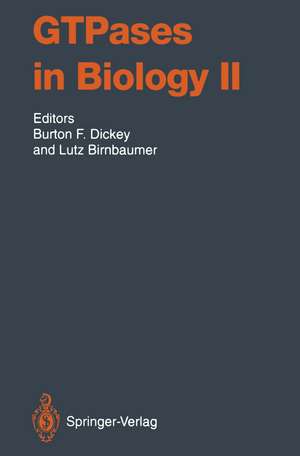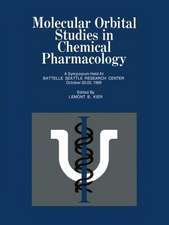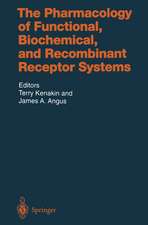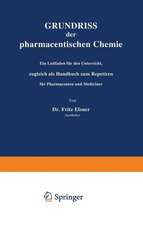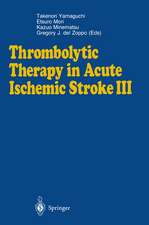GTPases in Biology II: Handbook of Experimental Pharmacology, cartea 108 / 2
Contribuţii de M. Biel, Lutz Birnbaumer, K.J. Blumer, J. Bockaert, E. Bosse, J.L. Boyer, P. Brabet, M. Camps, M.G. Caron, P. J. Casey, J. Chen, K. Clark, D. Corda, S. Coulter, P.N. Devreotes, D. Donelly, T.D.Jr. DuBose, J.H. Exton, J.B.C. Findlay, R.A. Firtel, V. Flockerzi, M. Forte, C. Gaskins, P. Gierschik, R. Gundersen, R.W. Gurich, J.R. Hadcock, J.A. Hadwiger, T.K. Harden, J.D. Hildebrandt, Y.-K. Ho, F. Hofmann, K.P. Hofmann, V. Homburger, M.D. Houslay, R. Hullin, D. Hyde, R. Iyengar, O. Jacobowitz, S. Jahangeer, K.H. Jakobs, G. L. Johnson, R.L. Johnson, N. Kimura, S.D. Kroll, Y. Kurachi, R. H. Lee, R.J. Lefkowitz, Y. Li, C. Londos, C.C. Malbon, D.H. Maurice, K.R. McLeish, G. Milligan, A. J. Morris, E.J. Neer, A.S. Otero, U. Panten, D. Park, G.S. Pitt, R.T. Premont, F. Quan, M. Rodbell, W. Rosenthal, M. Russell, P. Ruth, C. Schwanstecher, M. Schwanstecher, I.A. Simpson, E. Stefani, G. Szabo, J.A. Thissen, T.D. Ting, L. Toro, G.L. Waldo, A. Welling, T.G. Wensel, M. Whiteway, W. Wolfgang, L. Wuen Limba Engleză Paperback – 28 ian 2012
Din seria Handbook of Experimental Pharmacology
- 5%
 Preț: 3517.78 lei
Preț: 3517.78 lei - 5%
 Preț: 1425.97 lei
Preț: 1425.97 lei - 5%
 Preț: 1435.28 lei
Preț: 1435.28 lei - 5%
 Preț: 1430.52 lei
Preț: 1430.52 lei - 5%
 Preț: 1930.69 lei
Preț: 1930.69 lei - 5%
 Preț: 1922.47 lei
Preț: 1922.47 lei - 5%
 Preț: 1937.46 lei
Preț: 1937.46 lei - 5%
 Preț: 2117.58 lei
Preț: 2117.58 lei - 5%
 Preț: 2119.96 lei
Preț: 2119.96 lei - 5%
 Preț: 2117.38 lei
Preț: 2117.38 lei - 5%
 Preț: 1088.15 lei
Preț: 1088.15 lei - 5%
 Preț: 1098.27 lei
Preț: 1098.27 lei - 5%
 Preț: 1420.29 lei
Preț: 1420.29 lei - 5%
 Preț: 1104.84 lei
Preț: 1104.84 lei - 5%
 Preț: 1104.84 lei
Preț: 1104.84 lei - 5%
 Preț: 1108.14 lei
Preț: 1108.14 lei - 5%
 Preț: 1106.69 lei
Preț: 1106.69 lei - 5%
 Preț: 1105.77 lei
Preț: 1105.77 lei - 5%
 Preț: 1174.35 lei
Preț: 1174.35 lei - 5%
 Preț: 408.48 lei
Preț: 408.48 lei - 5%
 Preț: 409.63 lei
Preț: 409.63 lei - 5%
 Preț: 539.89 lei
Preț: 539.89 lei - 5%
 Preț: 720.47 lei
Preț: 720.47 lei - 5%
 Preț: 733.09 lei
Preț: 733.09 lei - 5%
 Preț: 731.27 lei
Preț: 731.27 lei - 5%
 Preț: 746.43 lei
Preț: 746.43 lei - 5%
 Preț: 747.72 lei
Preț: 747.72 lei - 5%
 Preț: 725.24 lei
Preț: 725.24 lei - 5%
 Preț: 742.80 lei
Preț: 742.80 lei - 5%
 Preț: 393.23 lei
Preț: 393.23 lei - 5%
 Preț: 728.33 lei
Preț: 728.33 lei - 5%
 Preț: 389.52 lei
Preț: 389.52 lei - 5%
 Preț: 730.71 lei
Preț: 730.71 lei - 5%
 Preț: 740.58 lei
Preț: 740.58 lei - 5%
 Preț: 730.19 lei
Preț: 730.19 lei - 5%
 Preț: 723.42 lei
Preț: 723.42 lei - 5%
 Preț: 731.27 lei
Preț: 731.27 lei - 5%
 Preț: 726.68 lei
Preț: 726.68 lei - 5%
 Preț: 3516.49 lei
Preț: 3516.49 lei - 5%
 Preț: 729.26 lei
Preț: 729.26 lei - 5%
 Preț: 737.11 lei
Preț: 737.11 lei - 5%
 Preț: 730.92 lei
Preț: 730.92 lei - 5%
 Preț: 738.78 lei
Preț: 738.78 lei - 5%
 Preț: 909.94 lei
Preț: 909.94 lei - 5%
 Preț: 720.10 lei
Preț: 720.10 lei - 5%
 Preț: 734.74 lei
Preț: 734.74 lei - 5%
 Preț: 727.80 lei
Preț: 727.80 lei - 5%
 Preț: 3513.38 lei
Preț: 3513.38 lei
Preț: 735.66 lei
Preț vechi: 774.39 lei
-5% Nou
Puncte Express: 1103
Preț estimativ în valută:
140.78€ • 146.15$ • 117.39£
140.78€ • 146.15$ • 117.39£
Carte tipărită la comandă
Livrare economică 25 martie-08 aprilie
Preluare comenzi: 021 569.72.76
Specificații
ISBN-13: 9783642783470
ISBN-10: 3642783473
Pagini: 660
Ilustrații: XL, 618 p.
Dimensiuni: 155 x 235 x 35 mm
Greutate: 0.91 kg
Ediția:Softcover reprint of the original 1st ed. 1993
Editura: Springer Berlin, Heidelberg
Colecția Springer
Seria Handbook of Experimental Pharmacology
Locul publicării:Berlin, Heidelberg, Germany
ISBN-10: 3642783473
Pagini: 660
Ilustrații: XL, 618 p.
Dimensiuni: 155 x 235 x 35 mm
Greutate: 0.91 kg
Ediția:Softcover reprint of the original 1st ed. 1993
Editura: Springer Berlin, Heidelberg
Colecția Springer
Seria Handbook of Experimental Pharmacology
Locul publicării:Berlin, Heidelberg, Germany
Public țintă
ResearchCuprins
Section IV: Signal Transduction by Trimeric G Proteins.- A. Cellular Architecture and its Role in Signal Transduction.- 44 G-Proteins Have Properties of Multimeric Proteins: An Explanation for the Role of GTPases in their Dynamic Behavior.- B. G-Protein Coupled Receptors.- 45 The Superfamily: Molecular Modelling.- 46 The Role of Receptor Kinases and Arrestin-Like Proteins in G-Protein-Linked Receptor Desensitization.- C. Trimeric G-Proteins.- 47 Qualitative and Quantitative Characterization of the Distribution of G-Protein ? Subunits in Mammals.- 48 Subunit Interactions of Heterotrimeric G-Proteins.- 49 G-Protein ? Subunit Chimeras Reveal Specific Regulatory Domains Encoded in the Primary Sequence.- 50 The GTPase Cycle: Transducin.- 51 Transcriptional, Posttranscriptional, and Posttranslational Regulation of G-Proteins and Adrenergic Receptors.- 52 G-Protein Subunit Lipidation in Membrane Association and Signaling.- 53 Phosphorylation of Heterotrimeric G-Protein.- 54 Receptor to Effector Signaling Through G-Proteins: ?? Dimers Join ? Subunits in the World of Higher Eukaryotes.- D. Effectors of G-Proteins.- 55 Molecular Diversity of Mammalian Adenylyl Cyclases: Functional Consequences.- 56 The Light-Regulated cGMP Phosphodiesterase of Vertebrate Photoreceptors: Structure and Mechanism of Activation by Gt?.- 57 High-Voltage Activated Ca2+ Channel.- 58 Phospholipase C-? Isozymes Activated by G?q Members.- 59 Stimulation of Phospholipase C by G-Protein ?? Subunits.- E. Specialized Systems.- 60 Rhodopsin/G-Protein Interaction.- 61 Fast Kinetics of G-Protein Function In Vivo.- 62 The Yeast Pheromone Response G-Protein.- 63 Ga Proteins in Drosophila: Structure and Developmental Expression.- 64 Signal Transduction by G-Proteins in Dictyostelium discoideum.- 65Functional Expression of Mammalian Receptors and G-Proteins in Yeast.- 66 G-Proteins in the Signal Transduction of the Neutrophil.- 67 Hormonal Regulation of Phospholipid Metabolism via G-Proteins: Phosphoinositide Phospholipase C and Phosphatidylcholine Phospholipase D.- 68 Hormonal Regulation of Phospholipid Metabolism via G-proteins II: PLA2 and Inhibitory Regulation of PLC.- 69 G-Protein Regulation of Phospholipase C in the Turkey Erythrocyte.- 70 Hormonal Inhibition of Adenylyl Cyclase by ?i and?? ?i or ?? ?i and/or ??.- 71 Neurobiology of Go.- 72 Involvement of Pertussis-Toxin-Sensitive G-Proteins in the Modulation of Ca2+ Channels by Hormones and Neurotransmitters.- 73 Regulation of Cell Growth and Proliferation by Go.- 74 Role of Nucleoside Diphosphate Kinase in G-Protein Action.- 75 G-Protein Regulation of Cardiac K+ Channels.- 76 Modulation of K+ Channels by G-Proteins.- 77 ATP-Sensitive K+ Channel: Properties, Occurrence, Role in Regulation of Insulin Secretion.- 78 Modulation of Maxi-Calcium-Activated K Channels: Role of Ligands, Phosphorylation, and G-Proteins.- 79 Regulation of the Endosomal Proton Translocating ATPase (H+-ATPase) and Endosomal Acidification by G-Proteins.- 80 cAMP-Independent Regulation of Adipocyte Glucose Transport Activity and Other Metabolic Processes by a Complex of Receptors and their Associated G-Proteins.- References.
